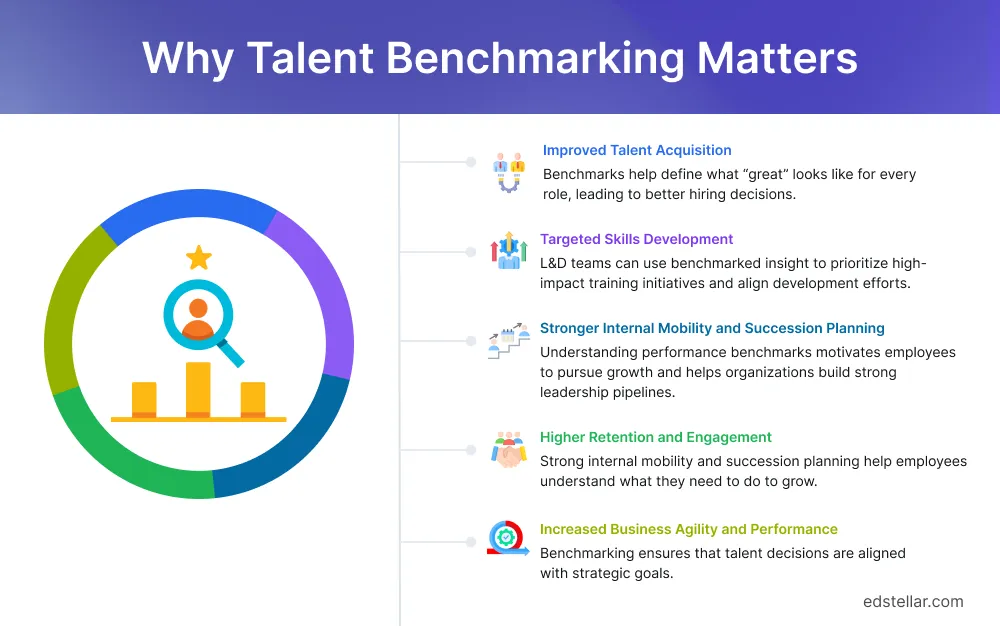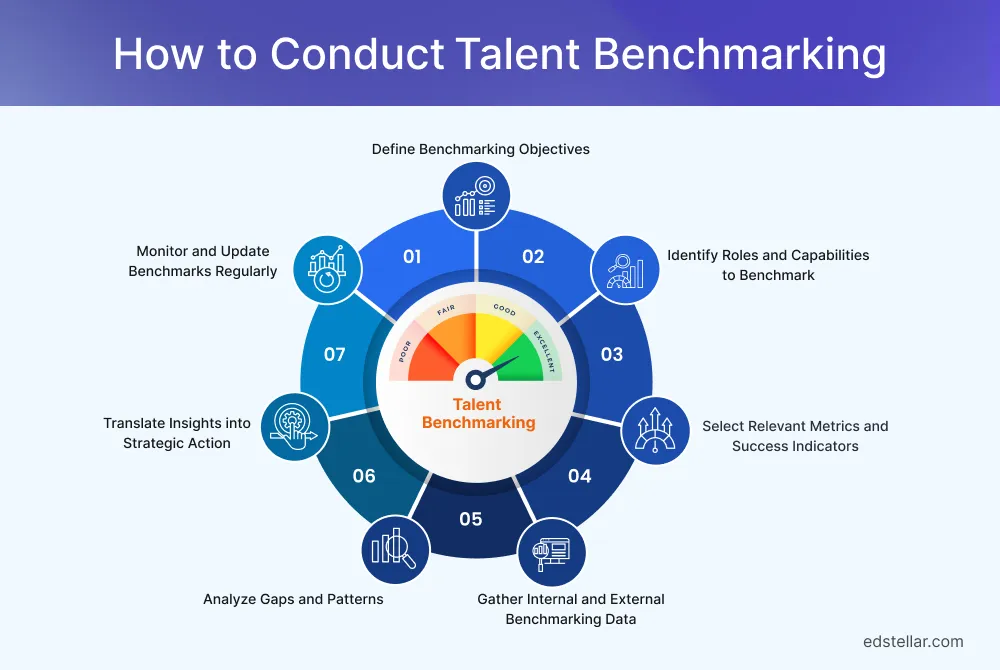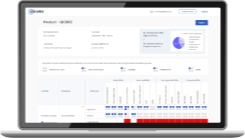
In today’s fast-paced and disruption-prone business environment, organizations cannot afford to make talent decisions based on guesswork. Leaders need precise, data-driven insight into how their workforce performs, both in relation to internal benchmarks and against external market standards. That’s why talent benchmarking has become a strategic necessity in modern workforce planning.
According to Deloitte’s 2024 Global Human Capital Trends report, executives rated human capabilities such as critical thinking, collaboration, and adaptability as top priorities for business performance and future readiness. This insight underscores a strategic imperative: organizations must move beyond legacy evaluations and outdated role definitions to understand and optimize the full range of employee strengths in real time.
Whether due to skill mismatches, talent underutilization, or inefficient succession pipelines, the disconnect between employee potential and business need continues to hinder agility and performance across industries.
This challenge is magnified by ongoing shifts in the workplace. As organizations adopt more project-based, hybrid, and AI-integrated operating models, static roles are giving way to dynamic capabilities. Leaders are being asked to manage talent not just by title or tenure, but by transferable skills, adaptability, and performance outcomes, none of which are captured through traditional HR frameworks.
For senior decision-makers, this transition demands a more precise, proactive approach to talent management. Talent benchmarking provides the structure and intelligence to do just that, helping organizations identify high performers, uncover skills gaps, and build robust leadership pipelines based on evidence rather than intuition.
For leaders seeking to future-proof their organizations, talent benchmarking isn’t just an HR initiative; it is a strategic necessity.
What is Talent Benchmarking?
Talent benchmarking is a structured, data-informed process used to evaluate workforce performance, skills, and potential by comparing individuals or groups against defined standards. These standards may be internal (e.g., top-performing employees in the same role) or external (e.g., industry averages, competitor benchmarks, or global competency frameworks). Unlike traditional performance reviews, which often focus on past achievements, talent benchmarking incorporates future potential, alignment with strategic objectives, and agility to meet evolving business demands.
At its core, talent benchmarking empowers HR leaders and business executives to make informed talent decisions, whether related to recruitment, internal mobility, succession planning, or workforce development. It helps organizations establish role clarity, align talent strategy with business goals, and optimize team composition for future readiness.
According to the McKinsey playbook for private equity portfolio-company CEOs, research indicates that companies that secure talent placement correctly within the first year of investment can achieve 2.5 times the return on initial investment.
Key Processes in Talent Benchmarking
Successful talent benchmarking is built on the following foundational elements:
- Role Clarity and Competency Definition: Benchmarking begins with clearly defined roles and competencies. Organizations must identify the core competencies, skills, and success criteria required for each position. This ensures evaluations are aligned with what truly drives performance in the business context.
- Data Collection and Assessment: Reliable benchmarking depends on high-quality data. Use structured assessments, performance reviews, self-evaluations, and manager feedback to build a comprehensive view of employee capabilities.
- Internal and External Comparison: Employees should be evaluated not only against internal top performers but also against external industry standards. This dual approach ensures organizations maintain a competitive talent edge while reinforcing internal consistency.
- Gap Analysis: Comparing current skills against benchmarks reveals development gaps and future needs. These insights help guide upskilling strategies, talent placement, and succession planning efforts.
- Continuous Monitoring and Adaptation: Business needs evolve, and so should benchmarks. Regularly updating benchmarks ensures the organization stays aligned with market trends, role changes, and strategic shifts.
McKinsey research found that organizations that consistently match high performers to strategically critical roles deliver disproportionate value. In fact, top performers in pivotal roles can generate up to 8 times greater productivity than average peers in the same position. This underscores the importance of talent benchmarking as a lever for optimizing role alignment.
McKinsey’s Performance Through People report analyzed 1,800 companies across 15 countries and identified a group of “People + Performance” (P+P) winners. These firms, which emphasize both human capital and performance, display greater earnings resilience, a superior ability to attract and retain talent, and superior financial returns relative to their peers.
Strategic Importance of Talent Benchmarking
In today’s dynamic business environment, talent benchmarking is not just an HR tool, it is a strategic enabler for enterprise-wide performance. Key benefits include:
- Business Agility: Enables faster, evidence-based decisions about talent deployment during disruption or growth.
- Succession Planning: Identifies leadership potential early, improving the robustness of talent pipelines.
- Workforce Optimization: Ensures that people are in roles that maximize their strengths and meet business needs.
- Increased Retention: Employees are likely to stay when development opportunities are tied to well-defined performance expectations.
- Diversity and Inclusion: Reduces bias by using standardized criteria rather than subjective impressions.
Why Talent Benchmarking Matters
In today’s rapidly changing business environment, talent benchmarking enables organizations to make sharper, faster, and more strategic workforce decisions. It provides a clear lens through which HR leaders can assess talent alignment, optimize development investments, and build future-ready teams.

By embedding benchmarking into workforce planning, organizations unlock several key benefits:
- Improved Talent Acquisition: Benchmarks help define what “great” looks like for every role, leading to better hiring decisions. With a clear profile of top performers, recruiters can assess candidate fit more effectively, enhancing the quality of hire and reducing time-to-fill.
- Targeted Skills Development: Benchmarking reveals gaps between current workforce capabilities and strategic requirements. L&D teams can use this insight to prioritize high-impact training initiatives and align development efforts with real business needs.
- Stronger Internal Mobility and Succession Planning: Employees who understand performance benchmarks are more likely to pursue growth opportunities. Benchmarking clarifies what’s needed to advance, creating transparency and motivation while helping organizations build robust leadership pipelines.
- Higher Retention and Engagement: When employees see a path to development and internal progression, engagement improves. This reduces turnover and preserves institutional knowledge, especially in mission-critical roles.
- Increased Business Agility and Performance: Benchmarking ensures that talent decisions are aligned with strategic goals. It enables faster redeployment, better cross-functional matching, and greater responsiveness to market shifts.
By shifting from reactive to proactive talent planning, organizations can benchmark their positions to adapt quickly, compete smarter, and lead confidently in an increasingly skills-based economy.
How to Conduct Talent Benchmarking
For executive leaders seeking to align their workforce strategy with business performance, talent benchmarking provides a structured approach to identifying capability gaps, enhancing hiring standards, and informing development investments. Implementing it effectively requires a disciplined approach rooted in data, clarity, and continuous refinement.
Below is a step-by-step framework for conducting talent benchmarking in a corporate environment:

1. Define Benchmarking Objectives
Begin by clearly articulating the business purpose behind the benchmarking initiative. Are you trying to improve hiring efficiency, build a leadership pipeline, reduce turnover, or align capabilities with strategic goals?
Why It Matters: Tie benchmarking efforts to a specific workforce challenge or strategic priority. This focus ensures the exercise yields actionable insights rather than becoming a purely diagnostic task.
2. Identify Roles and Capabilities to Benchmark
Select roles that are either mission-critical or high-impact positions that directly influence revenue, innovation, customer satisfaction, or operational performance. For each role, define the technical and behavioral competencies that drive success.
Collaborative Tip: Collaborate with business leaders to co-create success profiles. Use existing performance data to identify the traits, skills, and outcomes that differentiate top performers.
3. Select Relevant Metrics and Success Indicators
Determine what will be measured and what will be compared. Metrics may include:
- Job performance ratings
- Productivity/output levels
- Learning agility and upskilling capacity
- Engagement or retention scores
- Role-specific KPIs
Balanced Approach: Combine quantitative data (e.g., sales results) with qualitative inputs (e.g., peer reviews, behavioral traits) for a well-rounded profile.
4. Gather Internal and External Benchmarking Data
- Internal Benchmarks: Analyze performance data of high-performing employees in the target roles.
- External Benchmarks: Use industry reports, third-party assessment tools, or data from peer organizations to compare talent expectations across the market.
Implementation Note: Ensure data is standardized across sources. Use common scoring systems or frameworks to enable fair comparisons.
5. Analyze Gaps and Patterns
Compare current employee capabilities against the internal and external benchmarks. This step should reveal where your organization is exceeding expectations, meeting them, or falling short, both at the individual and organizational levels.
Visualization Tools: Use tools like a skills matrix, 9-box grid, or talent dashboard to visualize gaps and inform talent strategy discussions.
6. Translate Insights into Strategic Action
Use the results of your analysis to guide decision-making in areas such as:
- Talent acquisition criteria
- Learning and development investments
- Internal mobility and succession planning
- Organizational restructuring or upskilling priorities
Execution Strategy: Integrate insights into workforce planning cycles and leadership reviews to inform strategic decisions. Ensure follow-up actions are tracked and measured over time.
7. Monitor and Update Benchmarks Regularly
Roles evolve, industries shift, and technologies disrupt existing standards. Make benchmarking a continuous process by regularly reviewing and adjusting your benchmarks, at least annually or in alignment with business strategy refresh cycles.
Governance Recommendation: Establish cross-functional ownership between HR, L&D, and business units to maintain relevance and accountability.
Real‑World Examples of Talent Benchmarking
Here are two executive-level, real-world use cases showcasing how organizations have leveraged talent benchmarking to drive strategic outcomes in leadership development and team optimization.
1. Leadership Benchmarking in Succession Planning
A global enterprise implemented talent benchmarking to strengthen its leadership pipeline amid rising executive turnover. By comparing internal leadership candidates against benchmarked external profiles, the company assessed readiness and alignment to strategic needs.
- What was Benchmarked: Leadership competencies, cross-functional experience, and strategic decision-making capabilities.
- How it was Done: Internal candidates were assessed using competency frameworks grounded in executive-level experience and market-based benchmarks. Traditional assessments, 360-degree feedback, and external leadership models were used to evaluate potential candidates.
- Results Achieved: Internal promotions increased from less than 50% to nearly 65% for critical roles. The time-to-fill key leadership vacancies decreased by 40%, significantly reducing reliance on external hiring and enhancing continuity planning.
This aligns with broader findings that companies investing in internal benchmarking and succession planning gain higher retention and business stability. According to Deloitte’s CFO Signals survey, only about 50% of CFO roles in major ASX200 companies are filled internally, while 25% admitted to having no formal succession plan, pointing to the opportunity benchmarking provides when implemented correctly.
2. Sales Team Benchmarking at a SaaS Company
A rapidly scaling SaaS firm benchmarked top-performing sales reps to identify high-performance traits and close operational gaps across regions.
- What was Benchmarked: Sales metrics such as win rate, average sales cycle duration, client engagement frequency, and behavioral competencies like consultative selling.
- How it was done: The Top 15% of sales reps were profiled using performance analytics and behavioral assessments. All regions were then compared against these internal benchmarks to identify performance patterns and gaps.
- Results Achieved: Refinements to sales onboarding and coaching programs lifted average quota attainment by 18% within a year, while turnover among underperforming reps dropped by 20%, fueling stronger growth alignment.
Sales benchmarking is particularly effective in SaaS and technology sectors, where well-defined role behaviors and performance metrics directly influence retention, quota achievement, and customer expansion goals.
Why These Cases Matter
- They demonstrate how benchmarking drives talent pipeline development, reduces external hiring, and shortens time-to-fill critical roles.
- They show how benchmarking can identify high-performers and replicate success traits across underperforming groups.
- They reinforce that benchmarking can tie talent decisions directly to business metrics,such as revenue attainment and retention rates,making talent strategy both measurable and strategic.
Common Challenges in Talent Benchmarking
While talent benchmarking offers clear strategic value, organizations often encounter several practical challenges during implementation. Understanding and addressing these hurdles is critical to ensuring that benchmarking efforts produce meaningful, actionable insights.
Lack of Reliable External Benchmarks
Many organizations struggle to access dependable external data for benchmarking, especially for emerging roles or niche industries. Publicly available benchmarks may lack role specificity, be outdated, or fail to reflect regional or sector-specific dynamics. To address this, organizations typically take a phased approach:
- Engage with industry consortia or peer networks to access shared benchmarking data and collaborative insights.
- Partner with third-party research or talent analytics providers that offer validated, role-specific data aligned to your sector.
- Cross-reference external sources with internal top-performer profiles, ensuring that even limited external data is grounded in organizational context.
This multi-source strategy helps companies build a more reliable benchmarking foundation, even when market data is scarce or fragmented.
Incomplete or Inconsistent Internal Skills Data
Without up-to-date, standardized data on current employee skills and performance, it becomes difficult to establish meaningful comparisons. Many companies rely on static job descriptions or outdated evaluations. This lack of centralized, current data weakens the accuracy and effectiveness of talent benchmarking.
To address this challenge, organizations typically follow a structured approach:
- Initiate a comprehensive skills audit using surveys, assessments, or digital tools to capture current capabilities across functions.
- Establish a centralized skills inventory or skills matrix, enabling consistent tracking of both technical and soft skills across roles.
- Implement regular update cycles, incorporating manager feedback, employee self-assessments, and data from completed projects or certifications.
Example in Practice: A leading retail bank executed a large-scale skills audit involving over 500 employees, aligning assessed capabilities with the organization’s strategic goals. Data was compiled into a centralized skills matrix, and updates were tied to routine performance evaluations. The result: more targeted development plans and better resource allocation.
This audit-to-inventory workflow enables HR leaders to build a reliable skills foundation, ensuring that benchmarking efforts are accurate, actionable, and aligned with business needs.
Subjective Evaluation Criteria
When benchmarking relies solely on single-source feedback, such as manager’s rating, it risks introducing bias and inconsistency. This undermines the credibility of benchmarking and can lead to inaccurate decisions.
To create more objective and reliable assessments, organizations typically implement a structured process:
1. Adopt a standardized competency framework aligning role expectations with defined behaviors and proficiency levels.
2. Deploy multi-source feedback methods such as 360-degree reviews to gather insights from peers, direct reports, managers, and sometimes external collaborators.
3. Combine structured tools with manager and self-assessments to produce a balanced view of performance and potential.
Real-World Example: A multinational services firm introduced a competency-based evaluation system paired with 360-degree feedback for mid- to senior-level roles. Participants received aligned competency statements (e.g., leadership, collaboration, adaptability) and completed feedback cycles every six months. The organization reported a reduction in performance rating variance and improved engagement, as employees trusted the evaluation process more deeply.
Resistance from Stakeholders
Organizations frequently encounter skepticism from leaders and employees when introducing talent benchmarking. Some managers may see it as bureaucratic or threatening to their autonomy, while employees may view it as punitive instead of developmental.
To build acceptance and drive adoption, organizations typically follow this sequence:
- Define and communicate the purpose transparently, emphasizing that benchmarking is designed for growth, clarity, and alignment, not judgment.
- Engage stakeholders early, including leadership, department heads, and employee representative groups, to co-design success profiles and assessment frameworks.
- Demonstrate early wins, such as aligning high-potential talent with development initiatives or internal opportunities, to reinforce value and build momentum.
Real-World Example: A global organization undergoing a major change initiative successfully aligned diverse stakeholder groups, employees, management teams, and executives by involving them in framework design and communication planning. This inclusive approach led to significantly improved buy-in and reduced resistance across the transformation journey.
Misalignment Between Benchmarks and Business Goals
When benchmarking frameworks are created in isolation without input from business operations or evolving strategy, they risk becoming irrelevant or misaligned with organizational priorities.
How organizations typically respond:
- Anchor benchmarking efforts to strategic initiatives, such as digital transformation, omnichannel expansion, or customer experience programs.
- Include business unit leaders in defining role competencies and benchmarks that reflect operational realities.
- Review and update benchmarks regularly, ensuring they evolve with changing market demands and organizational objectives.
Conclusion
As roles evolve and market demands shift, the ability to align talent with strategy in real time becomes a defining capability. Talent benchmarking equips leaders with the insights to close skills gaps, retain high-potential employees, and ensure future-readiness.
To support organizations on this journey, Edstellar offers tools like its Skills Matrix and a catalog of 2000+ enterprise training programs, designed to help businesses assess, benchmark, and build capabilities with clarity and precision. These resources empower leadership teams to move from reactive talent management to proactive workforce development.
Talent benchmarking is more than a metric; it’s a foundation for sustainable, data-driven growth.
Explore High-impact instructor-led training for your teams.
#On-site #Virtual #GroupTraining #Customized

Bridge the Gap Between Learning & Performance
Turn Your Training Programs Into Revenue Drivers.
Schedule a ConsultationEdstellar Training Catalog
Explore 2000+ industry ready instructor-led training programs.

Coaching that Unlocks Potential
Create dynamic leaders and cohesive teams. Learn more now!


Want to evaluate your team’s skill gaps?
Do a quick Skill gap analysis with Edstellar’s Free Skill Matrix tool

Transform Your L&D Strategy Today
Unlock premium resources, tools, and frameworks designed for HR and learning professionals. Our L&D Hub gives you everything needed to elevate your organization's training approach.
Access L&D Hub Resources.svg)
.svg)



.svg)


.svg)
.svg)
.svg)
.svg)

